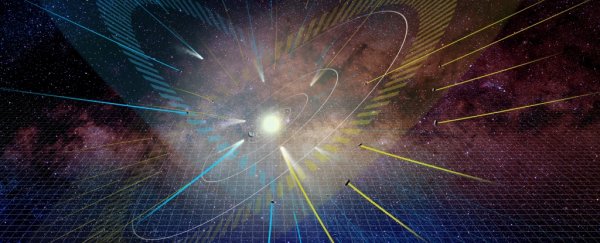If you could zoom out and look at the Solar System from a distance, you'd see that the illustrations have at least one thing right: the planets are, more or less, aligned on a flat plane, circling the Sun's equator.
This is called the ecliptic, and it's thought to be a remnant of how the Solar System formed - a flattish disc of dust swirling around the Sun that gradually clumped together into planets, asteroids, and other chunks of rock.
There are, however, a few bodies that move around outside this plane - mainly long-period comets with orbits of hundreds to tens of thousands of years, orbiting at the farthest reaches of the Solar System, in the Oort Cloud of icy bodies.
Now, we might understand their strange orbit. According to new research, some of these long-period comets seem to align along a different orbital plane - what its discoverers are calling the "empty ecliptic", rotated 180 degrees in respect to the galactic pole.
The finding could shed new light on how comets originally formed in the Solar System.
We can't actually observe the entire orbits of long-period comets. They're small, and dim, and we simply don't have the technology to see them past a certain point, not to mention that their orbits are much longer than a human lifetime. However, when they get close enough to the Sun for us to detect, we can use their trajectories and velocities to infer the entire orbits.
Astronomer Arika Higuchi from the University of Occupational and Environmental Health and the National Astronomical Observatory of Japan and her colleagues have been working on calculating the orbits of long-period comets for some time. In doing so, they noticed something interesting about the point in the orbits farthest from the Sun.
This point is called the aphelion, and it should remain pretty close to the ecliptic for bodies whose orbits originated on that plane. For some of the long-period comets, that was the case.
But there was a second group of long-period comets for which the projections did not indicate an aphelion consistent with the ecliptic. But nor were their aphelions randomly distributed; instead, they seemed to align along a second, otherwise unpopulated orbital plane.
The ecliptic is oriented 60 degrees in respect to the galactic plane. The new, empty ecliptic is also oriented 60 degrees from the galactic plane - but in the other direction. And that could be a clue to how the empty ecliptic came into existence.
It could have been generated, the researchers say, by the galactic tide - that is, the gravitational field of the galaxy itself. Over time, this could have pulled some of the long-period comets askew. That's why the team calls the second ecliptic 'empty' - it initially started that way, until, over billions of years, the galactic tide populated it with comets.
This is not an unknown concept; astronomers have been predicting an effect on Oort Cloud comets by the galactic tide for decades.
Still, it's an idea that needs more evidence to support it, so Higuchi and her team performed analytical computations to model how the galactic tide would influence long-period comets. Just as she predicted, the distribution of the aphelions had two distinct peaks - near the ecliptic and the empty ecliptic.
It's a very strong piece of evidence, but there's more work to be done to confirm the findings.
"The sharp peaks are not exactly at the ecliptic or empty ecliptic planes, but near them," Higuchi said.
"An investigation of the distribution of observed small bodies has to include many factors. Detailed examination of the distribution of long-period comets will be our future work."
The research has been published in The Astronomical Journal.
